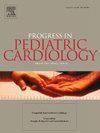利伐沙班治疗左心发育不全综合征患者的心室血栓
IF 0.8
Q4 PEDIATRICS
引用次数: 0
摘要
左心发育不良综合征(HLHS)是一种严重的先天性心脏病,其特征是左侧心脏结构发育不良。目前的护理标准旨在通过一系列分阶段的姑息性外科手术(通常是Fontan手术)来建立一个依赖于单心室(SV)的稳定循环。这些患者继发于循环异常及其后遗症(如蛋白质丢失性肠病(PLE))的系统性和脑室内血栓栓塞的风险更高。直接口服抗凝药物(DOACs)类药物通过直接抑制Xa因子起作用,这些药物由于其方便的口服途径和不需要频繁的治疗水平监测,在SV人群中预防和治疗血栓形成越来越受欢迎。虽然DOAC在成人患者中的应用已经得到了很好的探索,但在儿童SV人群中使用DOAC治疗脑室内血栓的文献报道仍然很少。我们报道了首例利伐沙班用于治疗心内血栓的病例,并描述了一名Fontan循环患儿的临床过程和结果。本文章由计算机程序翻译,如有差异,请以英文原文为准。
Treatment of a ventricular thrombus with rivaroxaban in a patient with hypoplastic left heart syndrome
Hypoplastic left heart syndrome (HLHS) is a severe form of congenital heart disease characterized by poor development of left-sided cardiac structures. The current standard of care aims to create a stable circulation that relies on a single ventricle (SV) by utilizing a series of staged palliative surgical operations, typically leading to a Fontan procedure. These patients are at higher risk of both systemic and intraventricular thromboembolism secondary to abnormal circulation and its sequelae, such as protein-losing enteropathy (PLE). The direct oral anticoagulant (DOACs) drug class acts by direct inhibition of factor Xa, and these medications are gaining popularity for the prevention and treatment of thromboses in the SV population due to their convenient oral route and lack of need for frequent therapeutic level monitoring. While the use of DOACs has been well explored in adult patients, there remains a paucity of literature reporting on DOAC use in the treatment of intraventricular thrombus in the pediatric SV population. We present the first reported case of rivaroxaban use to treat an intracardiac thrombus and describe the clinical course and outcome in a pediatric patient with Fontan circulation.
求助全文
通过发布文献求助,成功后即可免费获取论文全文。
去求助
来源期刊

PROGRESS IN PEDIATRIC CARDIOLOGY
PEDIATRICS-
CiteScore
0.90
自引率
11.10%
发文量
69
审稿时长
75 days
期刊介绍:
Progress in Pediatric Cardiology is an international journal of review presenting information and experienced opinion of importance in the understanding and management of cardiovascular diseases in children. Each issue is prepared by one or more Guest Editors and reviews a single subject, allowing for comprehensive presentations of complex, multifaceted or rapidly changing topics of clinical and investigative interest.
 求助内容:
求助内容: 应助结果提醒方式:
应助结果提醒方式:


